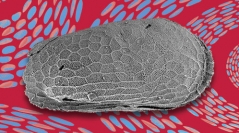

 Geodiversitas
47 (17) - Pages 687-703
Geodiversitas
47 (17) - Pages 687-703The oldest known ostracods from a chemosynthetic community at a cold seep were recently described from an authigenic carbonate lens enclosed within the Upper Jurassic (middle Oxfordian) Terres Noires Formation at Sahune in the south-eastern France Basin. Here we extend the observations to the entire sequence of fluid seepage at Sahune and compare them to those from marls deposited laterally. We report that ostracods are much more abundant throughout the authigenic deposits than within the enclosing marls. The composition of the assemblages is fairly stable over the period of emission of seep-type fluids, likely pointing to their relatively stable chemical composition. Communities are largely dominated by representatives of Pontocyprididae (e.g., Pontocyprella Mandelstam in Ljubimova, 1955), which seems to be a deep-sea feature within the south-eastern France Basin at least from the Oxfordian to the Early Cretaceous. We suggest that the observed abundance of ostracods within seep deposits, and particularly of pontocypridids, may be related to cold seep fluids and associated complex ecosystems. This complete analysis shows the persistent low diversity and distinct taxonomic composition of Sahune communities compared to contemporaneous platform and deep-water communities. For instance, the Cytheroidea Procytherura? praecoquum Forel in Forel, Charbonnier, Gale, Tribovillard, Martinez-Soares, Bergue, Gradstein & Gaillard, 2024 seems to have been adapted and endemic to the active centre of fluid emission, being absent from lateral marly sediments. Well-preserved specimens display morphological characters that were not visible at the time of species description, including fossae arrangement and distribution pattern of normal pores, which are described as a first step toward the clarification of the phylogeny and adaptation of Cytheroidea endemic to cold seeps. Within the limits of the preservation of the material, the valves of this species may display genuine pore clusters and more material may lead to the conclusion that it should be re-attributed to an environment-specific new genus.
Oxfordian, Ostracoda, south-eastern France Basin, Deep-sea, sequence of fluid seepage, extreme environments